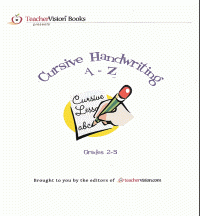Cursive Writing A to Z Workbook
This cursive writing A to Z workbook is a great aid to teach your students how to write the alphabet in cursive.
Worksheets can be used for practice in class or for homework. Each worksheet includes examples of each letter in upper and lowercase for your students to get use to writing in cursive. Also included in the workbook is practice writing difficult words in cursive including the letters.
Cursive Writing A to Z
Welcome to our guide on cursive writing A to Z. Whether you're a teacher looking to introduce cursive writing to your students, or a parent interested in practicing this skill at home with your child, this guide has you covered.
We'll walk through the benefits of learning cursive, answer common questions, and provide practical advice for teaching this beautiful and useful form of handwriting.
Why Teach Students Cursive Writing A to Z?
As a teacher in the digital age, you may find more and more parents asking why their child should learn to write in cursive. However, cursive writing is still an important skill to learn. Despite the prevalence of typing and digital note-taking, cursive writing holds its unique benefits:
Enhances Fine Motor Skills
Cursive writing requires a different set of motor skills than print writing. The fluid movement used in cursive writing helps in the development of fine motor skills.
Boosts Memory and Cognition
Research suggests that cursive writing activates different parts of the brain and can improve memory retention and cognitive development.
Improves Writing Speed
Cursive writing, by its very nature, allows for faster and more efficient writing than print. This can be particularly beneficial during timed exams or note-taking.
Facilitates Reading of Historical Documents
Many historical documents and letters are written in cursive. Hence, knowledge of cursive writing enables students to read and understand these documents.
Encourages Artistic Expression
Cursive writing is often viewed as an art form due to its elegant and flowing nature. It allows for personal expression and individuality in a way that print writing does not.
In conclusion, while it may seem outdated, cursive writing remains an important skill to learn. It not only aids in cognitive development, but it also opens up a world of historical understanding and artistic expression.

Frequently Asked Questions about Cursive Writing A to Z
1. At what age is it most appropriate to start teaching children cursive writing?
Most children are ready to start learning cursive writing between the ages of 7 and 8. This is the age when they have developed the necessary fine motor skills and hand-eye coordination. However, it can vary depending on the child's individual development.
2. Are there any effective methods or resources for practicing cursive writing at home?
Yes, there are many effective methods and resources available for practicing cursive writing at home. One of the best resources is this Cursive Writing A to Z Workbook from TeacherVision. It includes individual worksheets for each letter of the alphabet in both upper and lowercase cursive, as well as tips for writing full words. Our workbook allows children to practice writing cursive individual letters and more difficult words at their own pace.
3. Why do some people find it more challenging to write in cursive compared to print?
Cursive writing is a more complex skill compared to print because it requires a different set of motor skills and more hand-eye coordination. The fluid and continuous nature of cursive writing can be challenging to master, especially for those who are used to print writing where each letter is written separately. It's also common to find maintaining consistent size and spacing between letters difficult initially. However, with regular practice and patience, these challenges can be overcome.
4. How can parents support their children in learning cursive writing?
Parents can support their children in learning to write cursive by supplying plenty of practice material, such as this Cursive Writing A to Z Workbook. Regular practice is key to mastering cursive writing.
Parents can also encourage their children to write in cursive outside of school assignments, such as writing letters or journal entries in cursive.
Advice for Teaching Cursive Writing A to Z
When it comes to teaching cursive writing to young children, patience is key. Here are a few tips to help make the learning process smoother:
1. Start with the basics
Before diving into cursive writing, ensure the child is comfortable with print writing. It's also beneficial to start with simple letters before moving on to more complex ones.
2. Use the right tools
Make sure the child is using the right kind of writing tools, such as pencils that are comfortable to hold for a long period.
3. Provide plenty of practice
Regular practice is essential for mastering cursive writing. Use worksheets, like our Cursive Writing A to Z Workbook, for daily practice.
4. Make it fun
Incorporate games and fun activities into the learning process to keep the child engaged.
5. Give positive reinforcement
Always encourage and praise the child for their efforts. Remember, learning a new skill takes time and patience.
Finally, remember that each child is different, and it's okay if they take a little longer to master cursive writing. The important thing is to keep the learning process positive and fun.












